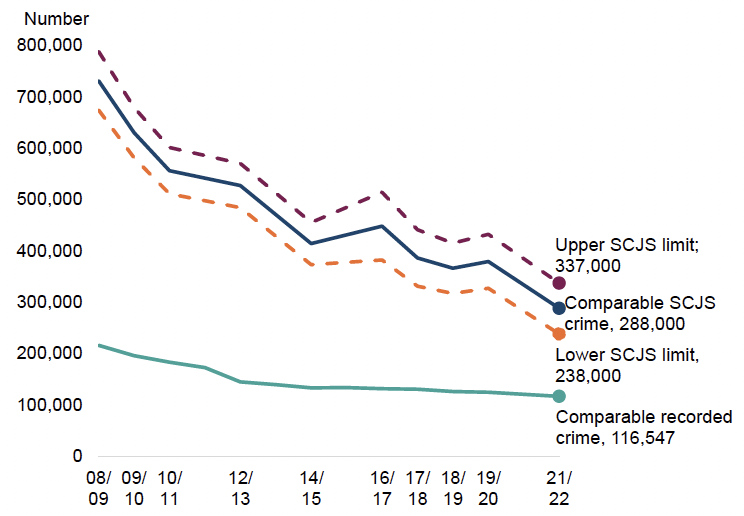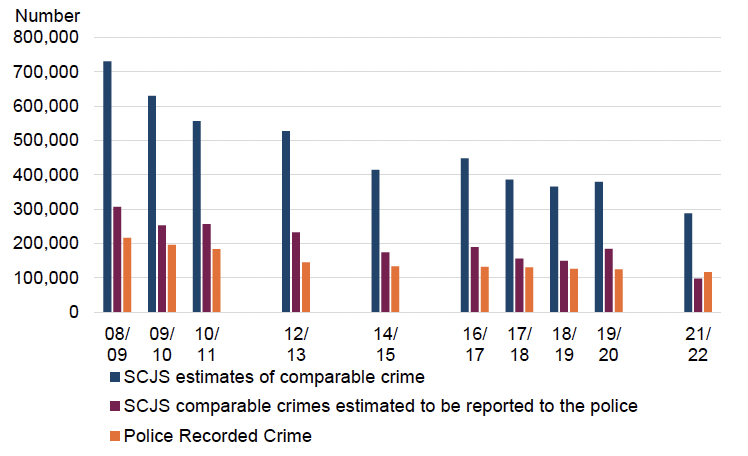Scottish Crime and Justice Survey 2021/22: Main Findings
Main findings from the Scottish Crime and Justice Survey 2021/22.
6. Bringing together crime statistics
Why are there two sources of crime statistics?
This chapter compares the Scottish Crime and Justice Survey (SCJS) and police recorded crime to help assess whether and to what extent they show consistent trends. It examines the scale of the difference between the volume of crime that is recorded by the police and the level of crime that is estimated by the survey to be experienced by the adult population living in households in Scotland. This builds on an analytical paper published in 2014.
A range of information is provided based on analysis of a sub-set of comparable crimes[58]. The two sources of crime statistics are reviewed briefly first, then the chapter looks at trends in these two sources over time, including a specific focus on three broadly comparable sub-groups: violent crime, acquisitive crime and vandalism[59]. Finally this chapter compares police recorded crime with the proportion of SCJS crime estimated to have been reported to the police.
Police recorded crime captures a broad range of crimes that are recorded by the police. It provides a good measure of crimes that are reported to and recorded by the police and is particularly useful for lower volume crimes that are challenging for sample surveys of the population to capture. Police recorded crime is used to develop and evaluate measures put in place to reduce crime, and to assess the performance of policing and criminal justice organisations. However, this data is sensitive to changes in recording practices and police activity, and does not include information about crimes that are not reported to, or recorded by, the police.
Crime surveys allow a wider assessment of the overall level of crime and likelihood of experiencing crime. They also provide a range of additional information, for example on the characteristics of crime, the relative likelihood of experiencing crime across the population and on repeat victimisation. However, surveys are often not as good at picking up some rarer crimes, crimes where there is no specific victim (for example, speeding), or where the victim is not covered by the survey sample (for example, crimes against businesses and children).
As well as these differences, the SCJS and police recorded crime also cover different timescales. The Recorded Crime in Scotland statistics cover crimes recorded by police over a 12 month period whereas the 2021/22 SCJS includes crimes experienced by SCJS respondents over a 25-month ‘reference period’[60]. Using the same approach to the comparisons with the CSEW discussed previously, the recorded crime data set used to compare is the year ending December 2022, as this best aligns with the latest fieldwork period, but is referred to here as 2021/22 for consistency.
Overall, the two sources each feature relative strengths and limitations, making them more appropriate in different contexts and for different purposes[61]. Taking account of these differences, comparisons between recorded crime and SCJS data can be made by examining a broadly comparable sub-set of crimes which are covered by each source. This sub-set of crimes are made up of those crimes that are coded in the survey in approximately the same way as they would be recorded by the police. Around three-in-five (58%) of ‘all SCJS crime’, as measured by the 2021/22 SCJS, fall into categories that can be compared with police recorded crime.
What are the trends in comparable SCJS and police recorded crime?
Of the 494,000 crimes estimated by the 2021/22 SCJS, around three-in-five (288,000) can be compared with police recorded crimes. Figure 6.1 demonstrates the scale of the difference between the two series of crime statistics. In 2021/22, the police recorded 116,547 crimes and offences[62] in the comparable sub-set, representing approximately two-in-five (41%) of the number of crimes in the SCJS comparable sub-set.
Figure 6.1: Both key sources of crime statistics in Scotland show a downward trend in the level of crime since 2008/09.

Sources: SCJS, Police recorded crime
There are a number of reasons for the difference between these two sources, including that SCJS estimates tend to be higher than recorded crime figures, even in the comparable category, because the survey is able to capture crime which does not come to the attention of the police. SCJS respondents were asked if the police came to know about an incident, just over a third (34%) of all crime in the comparable sub-set came to the attention of the police in 2021/22.
Both the SCJS and police recorded crime provide evidence of large decreases in crime in Scotland over the last 15 years or so. As shown in Table 6.1, the SCJS estimates that the volume of comparable crime fell by 61% between 2008/09 and 2021/22, whilst comparable recorded crime is down by 46% over the same period.
Table 6.1: Since 2008/09 SCJS estimates comparable crime fell by 61% while comparable recorded crime fell by 46%.
| Crime type | 2008/09 | 2019/20 | 2021/22 | Change since 2008/09 | Change since 2019/20 |
|---|---|---|---|---|---|
| Comparable SCJS crime | 731,000 | 379,000 | 288,000 | Down 61% | Down 24% |
| Comparable Recorded Crime | 215,901 | 124,500 | 116,547 | Down 46% | Down 6% |
| SCJS Acquisitive crime | 64,000 | 46,000 | 29,000 | Down 54% | Down 37% |
| Recorded acquisitive crime | 27,527 | 15,919 | 13,049 | Down 53% | Down 18% |
| SCJS violent crime | 317,000 | 194,000 | 134,000 | Down 58% | No change |
| Recorded violent crime | 82,855 | 63,421 | 63,018 | Down 24% | Down 1% |
| SCJS vandalism | 350,000 | 139,000 | 125,000 | Down 64% | No change |
| Recorded vandalism | 105,519 | 45,160 | 40,480 | Down 62% | Down 10% |
Sources: SCJS; Police recorded crime; SCJS Base: 2008/09 (16,000); 2019/20 (5,570); 2021/22 (5,520).
Note: changes in SCJS results specified were statistically significant.
Since 2019/20, the SCJS found a 24% decrease in the level of comparable crime, whilst comparable recorded crime fell by 6%.
In March 2021, Her Majesty’s Inspectorate of Constabulary in Scotland (HMICS) published the results from their 2020 audit of incidents and crimes recorded by Police Scotland, with the report stating that ‘the results show that compliance is generally good, however there is still room for improvement’.
The following section looks at comparable acquisitive crime, violent crime and vandalism in more detail.
Acquisitive crime
The acquisitive comparable crime group includes bicycle theft, housebreaking and theft of a motor vehicle. In 2021/22 the SCJS estimated that there were 29,000 acquisitive crimes (+/- 8,000, meaning that the true number of acquisitive crimes experienced by the population is estimated to be between 21,000 and 37,000[63]). The police recorded 13,049 acquisitive crimes in 2021/22.
Both SCJS estimates and recorded acquisitive crime figures decreased between 2008/09 and 2021/22 (by 54% and 53% respectively). Since 2019/20 police recorded acquisitive crime has decreased by 18%, and the SCJS found a 37% decrease in acquisitive crime. Where SCJS estimates are based on the experiences of a relatively small number of people, it can often be challenging to detect significant changes between adjacent survey years[64].
Violent crime
Violent comparable crime includes serious assault, minor assault[65] and robbery. In 2021/22, the SCJS estimated that there were 134,000 violent crimes[66] (+/- 43,000, meaning that the true number of violent crimes experienced by the population is estimated to be between 91,000 and 177,000), while the police recorded 63,018 violent crimes.
Table 6.1 shows that the two sources of comparable violent crime data both show large decreases over the longer term, while the SCJS shows no significant change since 2019/20. Between 2008/09 and 2021/22, both SCJS estimates and police recorded violent crime figures have shown a decrease (by 58% and 24% respectively)[67]. Since 2019/20, comparable police recorded violent crime has shown a small decrease (down 1%), while the SCJS found no change in violent crime.
Vandalism
The vandalism comparable crime group includes motor vehicle vandalism and property vandalism. In 2021/22 the SCJS estimated that there were 125,000 instances of vandalism (+/- 22,000, meaning that the true number of vandalism crimes experienced by the population is estimated to be between 103,000 and 147,000). The police recorded 40,480 vandalism crimes in 2021/22.
The trends in comparable crimes of vandalism across both the SCJS and police recorded crime between 2008/09 and 2021/22 are similar – with the SCJS showing a decrease of 64% and police recorded crime showing a decrease of 62%. Since 2019/20 there has been no change in the SJCS estimate of vandalism, while crimes of vandalism recorded by the police have fallen by 10%.
Comparing police recorded crime against volume of SCJS crime estimated to have been reported to the police
SCJS respondents are asked whether the police ‘came to know about’ the crime, either from them or somebody else. This allows comparisons to be made between comparable crime estimated to have been reported to the police in the SCJS (i.e. a sub-set of comparable crime), and police recorded crime figures.
The previously cited analytical paper published in 2014, outlined two methods for calculating this; the first, comparing the (at that time) biennial SCJS to annual recorded crime figures and the second comparing the biennial SCJS against two reporting years of averaged police recorded crime data. This section updates the information using the first method, to compare now annual SCJS estimates to annual recorded crime figures[68]. Although it is not possible to determine on an individual basis whether a crime that the police ‘came to know about’ was captured in police recorded crime data, this type of analysis can give an indication of the level of crime that goes unrecorded, and the broad relationship between police recorded crime figures and SCJS estimates.
Figures from the 2021/22 SCJS indicate that of the 288,000 crimes in the overall comparable sub-set, around 97,000 incidents (34%) were estimated to have been reported to police. Figure 6.2 displays the difference by volume between SCJS comparable crimes estimated to be reported to the police (as a sub-set of all SCJS crime) and police recorded crime for all years since 2008/09.
Figure 6.2: In 2021/22, for the first time, the number of crimes recorded by the police was higher than the number of comparable crimes estimated to have been reported to the police.

Sources: SCJS, Police recorded crime.
In 2021/22, the police recorded 116,547 crimes in the comparable category. Figure 6.3 shows that, for the first time since 2008/09, this is greater than our estimate of the number of comparable crimes that were reported to the police (97,157). The primary driver for this difference is likely to be the reduction in the proportion of crimes that came to the attention of the police, which fell from 48% of comparable crime reported in 2019/20 to 34% in 2021/22. As discussed in Chapter 3 there are a number of reasons why caution should be taken with this figure such as:
- a greater chance of volatility given falling victimisation rates over the longer term
- the impact of the covid pandemic, specifically for those respondents interviewed near the start of the latest sweep of fieldwork
- a smaller reduction in police recorded crime (down 6%) that might be expected if the proportion of crimes being reported to the police had fallen by the amount implied by the survey
We will continue to monitor this to see if this becomes an emerging trend in the future surveys.
Contact
Email: scjs@gov.scot
There is a problem
Thanks for your feedback